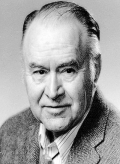Judson Brown Memoriam

Judson S. Brown, Ph.D., Professor Emeritus of Behavioral Neuroscience (formerly Medical Psychology) in the School of Medicine at OHSU died on August 28, 2005 at the age of 95. Dr. Brown earned his Ph.D. in psychology at Yale University in 1940 under the guidance of Dr. Neal E. Miller. After brief appointments as an Instructor at both Harvard and Yale, he spent several years in Texas during WWII working as an Aviation Research Psychologist affiliated with the U.S. Army Air Forces. Upon returning to civilian life, Dr. Brown accepted a faculty appointment in the Department of Psychology at the University of Iowa, where he spent the next 14 years of his career, advancing to the rank of Professor. He then spent 2 years as a Graduate Research Professor at the University of Florida. Dr. Brown first came to Oregon in 1962 as Professor of Medical Psychology in the School of Medicine, but in 1965 he was recruited back to the University of Iowa to serve as Chair of the Department of Psychology until 1970. In 1972, he returned to the Oregon School of Medicine to play a key role in the early development of the Medical Psychology department’s basic research and training programs in the field of alcoholism. He continued in that role until his retirement and emeritus appointment in 1980. Dr. Brown was highly regarded for his rigorous, analytical and innovative approaches to fundamental empirical and conceptual issues in the field of motivation. During his long career, he published many seminal articles on emotion, frustration, approach-avoidance conflict, the measurement of conditioned fear, and various other acquired drives. In 1951, he (together with H. I. Kalish and I. E. Farber) was the first to describe the procedure of using alteration in the reflexive startle response to percussive sound as an index of conditioned fear in rodents. This procedure is still widely used today to study the neurobiology of fear, learning and memory. His 1961 textbook on The Motivation of Behavior was broadly adopted for courses taught at the graduate and advanced undergraduate level for many years. For much of the later part of his career, his research program focused on characterizing an animal model of self-punitive (“masochistic”) behavior. Even in retirement, he continued his career-long pursuit of ever better approaches to the concept of motivation. His last paper, published in 1991, was entitled, “Defining being motivated: Alternative operational formats.”
In addition to his basic research accomplishments, Dr. Brown made many important professional contributions during his career. Of particular significance, he served as the President of the Midwestern Psychological Association, the President of the Division of Experimental Psychology of the American Psychological Association (APA), and the Chairman of the Board of Governors of the Psychonomic Society. He was also a member of the Society of Experimental Psychologists, the APA Board of Scientific Affairs, the APA Council of Representatives, and several NIH Study sections. He served as a Consulting Editor for several prominent journals, including the Journal of Experimental Psychology and Psychological Review.
During his years in Iowa and Oregon, Dr. Brown taught and supervised the research training of many graduate students, most of whom went on to pursue successful academic and research careers in the fields of psychology and behavioral neuroscience. His students remember him for his integrity, generosity, high intellectual standards and relentless pursuit of rigorous operational definitions for common motivational concepts. He was also well known for his expertise in building and troubleshooting electronic equipment (e.g., the Hunter-Brown decade interval timer) and for making sure all of his students thoroughly understood Ohms Law. Dr. Brown was also a highly accomplished photographer whose limited-edition full color prints were often exhibited at galleries in Oregon, Iowa and New York. He had a unique ability to capture ordinary subjects in extraordinary ways that are striking, beautiful and penetrating. His students delighted in the frequent opportunities he provided to select prints from his collection, especially because he refused to accept any payment.